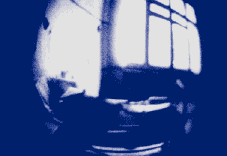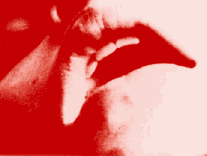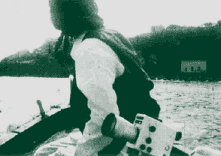| Karel Doing | |||
| Rainbow
Stories
16mm colour opt. 95 min. 1996    |
|
Rainbow Stories: a compilation. Nine filmmakers and filmcollectives from various European countries, each having earned their place in film-art/art-film, shot an episode on black-and-white Super8, after which the episodes were compiled on 16mm and coloured, each with a different colour of the spectrum. Thus a kaleidoscopic image was formed of the many styles and expressions in which the frontier of art and film is explored in contemporary Europe. The idea of Rainbow Stories was taken from the book by the same name from writer/war correspondent William T. Vollmann (Pan Picador, London 1990), a compilation of stories with associative links to the various colours in the spectrum. Just like in the book, there is a vast variety of styles and subjects in the nine episodes. - Janneque Draisma (NL) De Iside ed Osiride - red Originally I approached the film medium as a window. I designed sequences in which figures performed a choreography, based on a theme and with a short story as a lead: 'Cinematic Choreographies' or 'Visual Poems'. Now my films are slowly developing into books or buildings with increasingly complex structures and contents. The choreography is shaped into an act with a dramatic content. The figures become characters with texts. During the shoot I leave some space for unexpected happenings which may influence the story and become part of the film. Currently I am concentrating on a more documentary style of filmmaking, with a strong emphasis on observation. - BarBara Hanlo (NL) A Wind Rose - green The -unreeling of a film, before a lamp, in a dark space, again and again- watching, listening, thinking and feeling. Rewind and start again. - Tina Keane (UK) Beyond the Blue Grain - bleu I use Super8 as a sketch pad, a means to collect the elements of my visual language. The sketches are then inputted into a process of transformation. I am a promiscuous gatherer, liberating the images from their material constraints and creating, with a painter's sensibilities, richly layered and compelling work. Technology for me is an active ingredient, the process through which my work evolves and engages with a conceptual momentum; I may begin with Super8, find expression in video installation/performance, and reach completion with a single screen film. - Harald Busch (D) Taking Place - yellow For the past ten years my work has been shifting from film to video to installation to objects/sculptures and back again. So maybe I could define myself as a non-specialist, whose work is based on something one might call formal preciseness (or at least a longing for it). In one way or another it always had and has to do with 'contradictions', as between planning and improvising, as between motion and immobility, as between close-up and long-shot, as between fear and joy, as between seeing and not seeing and I guess that's where it always is 'TAKING PLACE': in between. - Cane CapoVolto (I) Mal d'Africa - green Cane Capovolto is an open collective which uses film and video as a means of testing the notions of communication and perception. The moving images of Cane Capovolto are conceived from a combination of early surrealist film and Trash cinema. They make a strong reference to (fake) freak documentaries of the 1960's 'Mondo Movies'. All of our shorts originate on Super8 because of the many falsifying possibilities of this medium. The use of Super8 implies both a more realistic as well as sharper perception of reality. Since 1992 Cane Capovolto has experimented with irrational combinations of found or stolen film and video footage, texts and sounds and has therefore since then completely exhausted this 'ideological, three-dimensional Found Footage Cinema'. - Nina Danino (UK) The Silence is Baroque - purple Structure is an organising principle, the elements where lengths of film itself, such as in my first film 'First Memory' where I discovered the power of duration and and the possibilities of voice over image and black film and in 'Close to Home' working with distance -the sea and black spacing and the voice to create, tensions brought forth as a result of what cannot, in the end, be located in any physical geography. A guiding principle has been the feeling that the feminine is an idea which can map out something also in connection with art perhaps. The drama of 'Stabat Mater' is in the ascent of a voice in song, the full colour and gestural and frenetic camera against a breathless unpunctuated speech. 'Now I am Yours' carries on working with the voice and the image as syntax, and I worked with such wonderful voice artists as Shelley Hirsch, creating a connection of sound and image. This film is baroque in every way and perhaps excessive in its struggle to say and reach. Now, with 'The Silence is Baroque' for Rainbow Stories, I have tried to make a noisy, lively, musical piece around spectacle and theatre, not high but low; the music, realism and poetry of the street - the applause for life pitted against the celebration of passion and death. - Barr & Ferral (UK) Visitations - red Barr/Ferral films make use of relatively cheap film/video formats and production methods. While our earliest film work used mainly VHS/SVHS video, most of our current work employs black and white 8mm/16mm film which we hand process and hand tint at home. Whatever the medium used, a common stylistic feature of our films is the exploration of the particular qualities and limitations of that medium. We usually film in a very direct, improvisatory way often with little or no idea how an image will eventually be used. There is no acting as such in our films. Filming sessions usually involve the recording of real experience or documentation of personal ritual. Visual processing, editing and juxtaposition of this material will often create a distance from this reality resulting in something quite surreal. Our film making is a continuous, ongoing project with themes, ideas and images often interchangeable from one film to another. A common thread throughout our 26+ films is the representation of the human body. The body is often viewed from a distant, almost alien perspective. The flesh is presented as fascinating and erotic but prone to invasion and corruption by disease. In some of our films the body becomes dehumanised to a point where it may actually be alien. This is particularly apparent in our segment of Rainbow Stories. - Marc Geerards (NL) Don't Move! - bleu So far I have only used literature (Kafka, Duras, Rilke, Beckett) as a base material for my films. But I am also working with other than literary sources. What interests me is the application of the method. Like, when you start from a book, you can write a film, when you start from a picture, you can paint a film, when you start from a choreography, you can dance a film, when you start from a piece of music, you can compose a film, etc. So far, the method has always been up front in my work. Maybe it is true that these films are first and foremost reflections of the method -that the method is their actual subject- and that they only show us thereafter what the camera and microphone have recorded. But recently I have started to leave some more room for chance and experimentation (especially during the shoot and the editing). Systematics and improvisation seem to come together. - Bavo Defurne (B) Saint - red After my study film & video realization at the HIBK Sint Lukas Brussels I worked as a set dresser for Peter Greenaway and as an assistant director for Matthias Müller. Since 1989 I have made about twenty films and video's. I like to experiment with new images, but I also refer to silent movies, pre-war propaganda films, videoclips and advertisements. The experiment is clearly aimed, in that I will try to find a powerful and particular way of expressing something important with image and sound. I always involve peolple from the mainstream as well as the underground film scene in my productions. My method of working results in a rough, professional authenticity which could never be achieved within the conventions of standardised commercial film industry. The main subject of my films is the visualisation of the body in the context of contemporary society. |